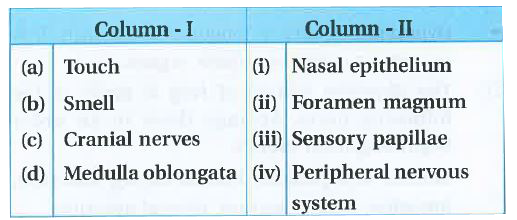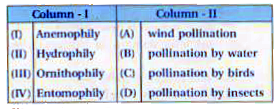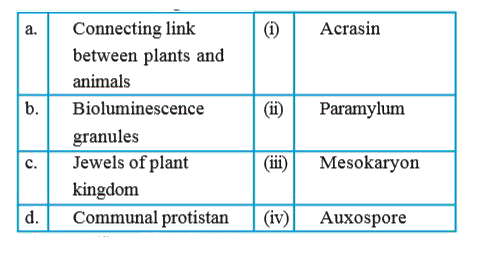Match the followings and choose the correct answer.

(A) (a - ii), (b - iii), (c - iv), (d - i)
(B) (a - iii), (b - ii), (c - iv), (d - i)
(C) (a - i), (b - iii), (c - ii), (d - iv)
(D) (a - ii), (b - iv), (c - iii), (d - i)Solution in Gujrati
(a - ii), (b - iii), (c - iv), (d - i)
(a - iii), (b - ii), (c - iv), (d - i)
(a - i), (b - iii), (c - ii), (d - iv)
(a - ii), (b - iv), (c - iii), (d - i)
The correct Answer is:A
In Hermaphrodites : Testes and ovaries both are situated in same animal. e.g. earthworm or planaria. Direct development / growth : In living organisms, direct developm ent takes place without nym phal stage m eans no transformation process is seen. e.g. Pheretima and Lumbricus. Chemical sensory : It is a process showing sensitivity towards chemicals, eg. smell sensory and taste sensory in mammals. In earthworm, blood glands are specific glands. They are associated with blood cells and formation of Haemoglobin in Pheretima.
Topper's Solved these Questions
- STRUCTURAL ORGANISATION IN ANIMALSBOOK - KUMAR PRAKASHANCHAPTER - STRUCTURAL ORGANISATION IN ANIMALSEXERCISE - SECTION-E (SOLUTION OF NCERT EXEMPLAR) (VERY SHORT ANSWER TYPE QUESTIONS)
13 Videos
- STRUCTURAL ORGANISATION IN ANIMALSBOOK - KUMAR PRAKASHANCHAPTER - STRUCTURAL ORGANISATION IN ANIMALSEXERCISE - SECTION-E (SOLUTION OF NCERT EXEMPLAR) (SHORT ANSWER TYPE QUESTIONS)
20 Videos
- STRUCTURAL ORGANISATION IN ANIMALSBOOK - KUMAR PRAKASHANCHAPTER - STRUCTURAL ORGANISATION IN ANIMALSEXERCISE - SECTION-D(TEXTUAL EXERCISE)
32 Videos
- SAMPLE QUESTION PAPER FOR SECOND EXAMBOOK - KUMAR PRAKASHANCHAPTER - SAMPLE QUESTION PAPER FOR SECOND EXAMEXERCISE - SECTION - D
1 Video
- THE LIVING WORLDBOOK - KUMAR PRAKASHANCHAPTER - THE LIVING WORLDEXERCISE - OBJECTIVE SECTION (FILL IN BLANKS)
9 Videos
Similar Questions
State the number of segments in earthworm which are covered by a prominent dark band or clitellum
View SolutionGive the location of hepatic caeca in a cockroach. What is their function ?
View SolutionGive the common name of Periplaneta americana.
View SolutionExplain Double circulation with the help of chart.
View SolutionA .......... is a collection of pressed, dried and preserved plants mounted on ……..
View SolutionMatch the column-
Column IColumn IIA Toxinsi. MorphineB Alkaloidsii. AbrinC Lectinsiii. VinblastinD. Drugsiv. Concanavalin A
ABCDiiiiiiiviiiiiiiviiiiviiiviiiiii
View SolutionMatch the items in column 'A' and column 'B' and choose correct answer.
ColumnAColumnB(i)Lady bird(A)Methanobacterium(ii)Mycorrhiza(B)Trichoderma(iii)Biological control(C)Aphids(iv)Biogas(D)Glomus
The correct answer is A. (i)-B (ii)- D (iii)-C (iv)-A B. (i)-C (ii)- D (iii)-B (iv)-A C. (i)-D (ii)-A (iii)-B (iv)-C D. (i)-C (ii)-B (iii)-A (iv)-D
View SolutionMatch the following with reference to cockroach and choose the correct option. (A) (a - iii), (b - iv), (c - ii), (d - i) (B) (a - iv), (b - iii), (c - ii), (d - i) (C) (a - iv), (b - ii), (c - iii), (d - i) (D) (a - ii), (b - iv), (c - iii), (d - i)
View SolutionMatch the followings and choose the correct answer.

(A) (a - iii), (b - i), (c - ii), (d - iv)
(B) (a - ii), (b - i), (c - iv), (d - iii)
(C) (a - iii), (b - iv), (c - ii), (d - i)
(D) (a - iii), (b - i), (c - iv), (d - ii)
View SolutionMatch the following column .
Column -I Column-II (a) Molecular oxygen (i) α− ketoglutaric acid (b) Electron acceptor (ii) Hydrogen acceptor (c) Pyruvate dehydrogenase (iii) Cytochrome -C (d) Decarboxylation (iv) Acetyl Co-A
(A) (a-ii),(b-iii),(c-iv),(d-i)
(B) (a-iii),(b-iv),(c-ii),(d-i)
(C) (a-ii),(b-i),(c-iii),(d-iv)
(D) (a-iv),(b-iii),(c-i),(d-ii)
View SolutionMatch the two columns: (A) (I-A),(II- B), (III- D), (IV- C) (B) (I-B), (II-A), (III-D), (IV - C) (C) (I- A), (II-B), (III-C), (IV- D) (D) (I- D), (II- A), (III-C), (IV-B)
View SolutionMatch the two columns:

(A) (I-C), (II-D), (III-B), (IV-A)
(B) (I-D), (II-C), (III-A), (IV-B)
(C) (I-C), (II-B),(III-D), (IV-A)
(D) (I-B),(II-D),(III-C),(IV-A)
View SolutionMatch the two columns:

(A) (I-A), (II-B), (III-C), (IV-D)
(B) (I-B), (II-A), (III-C), (IV-D)
(C) (I-A), (II-C), (III-B), (IV-D)
(D) (I-D), (II-B), (III-C), (IV-A)
View SolutionMatch the animals given in column A with their location in column B.
Column AColumn B(i)DodoA.Africa(ii)QuaggaB.Russia(iii)ThylacineC.Mauritius(iv)Stellar's sea cowD.Australia
Choose the correct match from the following.
(a) i-A, ii-C, iii-B, iv-D
(b) i-D, ii-C, iii-A, iv-B
(c) i-C, ii-A, iii-B, iv-D
(d) i-C, ii-A, iii-D, iv-B
View Solution
1 a(iii), b(ii), c(i), d(iv)
2 a(i), b(iv), c(i), d(iii)
3 a(iv), b(i), c(iii), d(iv)
4 a(ii), b(iii), c(iv), d(i)
View Solution